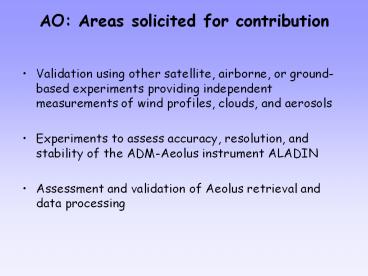AO: Areas solicited for contribution - PowerPoint PPT Presentation
1 / 12
Title:
AO: Areas solicited for contribution
Description:
Comparisons with photometer. Measurements from Milagro campaign. Airborne Aerosol Comparisons ... lidar and a sun photometer to retrieve aerosol backscatter to ... – PowerPoint PPT presentation
Number of Views:49
Avg rating:3.0/5.0
Title: AO: Areas solicited for contribution
1
AO Areas solicited for contribution
- Validation using other satellite, airborne, or
ground-based experiments providing independent
measurements of wind profiles, clouds, and
aerosols - Experiments to assess accuracy, resolution, and
stability of the ADM-Aeolus instrument ALADIN - Assessment and validation of Aeolus retrieval and
data processing
2
US Cal-Val Effort Investigators
- Mike Hardesty, NOAA/ESRL
- Dave Bowdle, University of Alabama Huntsville
- Jason Dunion, NOAA/AOML
- Ed Eloranta, University of Wisconsin
- Dave Emmitt, Simpson Weather Associates
- Brian Etherton, University of North Carolina
Charlotte - Rich Ferrare NASA Langley
- Iliana Genkova, University of Wisconsin
- Bruce Gentry, NASA Goddard
- Gary Gimmestad Georgia Tech Research Instrument
- Ross Hoffman, AER, Inc.
- Chris Hostetler NASA Langley
- John Hair, NASA Langley
- Michael Kavaya, NASA Langley
- Matt McGill, NASA Goddard
- Lars Peter Riishojgaard JCSDA
- Chris Velden, University of Wisconsin
- Zhaoxia Pu, University of Utah
3
Goals of the US Aeolus Cal/Val Effort
- Obtain and analyze aircraft measurements of wind
speed, aerosol structure, aerosol backscatter,
aerosol extinction, cloud climatologies and
relevant parameters under the Aeolus flight track
using remote sensors and dropsondes, Develop
a data set extending over the life of the mission
from surface remote sensors and in situ sensors
(radiosondes, dropsondes, aircraft winds) by
gathering and analyzing measurements when Aeolus
measurement volume coincides with sensor
observational locations, Investigate
correlations, differences and synergisms between
Aeolus and Atmospheric Motion Vector winds
derived from cloud and water vapor motion
Investigate Aeolus data quality based on data
assimilation studies
4
Current status
- Proposals were reviewed within ESA and by members
of ADM Advisory Group - Proposers were asked to address certain points
and to submit revised proposals - Our revised proposal was accepted
- Next step Locate funding
5
Airborne Wind Studies
- Lower troposphere studies (Hardesty and Emmitt)
- Apply low energy, high prf systems (HRDL and
TODWL to investigate Aeolus performance in high
aerosol regions - Study effects of mesoscale atmospheric
inhomogeneities on Aeolus measurements - Structured aerosol field
- Broken cloud fields
- Wind shear and horizontal circulations, vertical
motions - Full tropospheric studies (Gentry and Kavaya)
- Apply TwiLite instrument for comparisons with
Aeolus of direct detection winds as opportunities
present (focus on severe storms) - Apply DAWN lidar for free tropospheric studies to
investigate effects of clouds, wind gradients,
etc., as opportunities present - Potentially compare Aeolus with notional hybrid
of DAWN and TwilLite can fly together.
6
Airborne Aerosol Comparisons
- Apply LaRC Airborne High Spectral Resolution
Lidar to validate Aerolus aerosol/cloud
extinction and backscatter data products
(Hostetler, Hair, Ferrare) - Conduct flights along the Aeolus sampling curtain
under different atmospheric conditions and
measurement scenarios - Compare estimates of backscatter and extinction
directly computed by HSRL with Aerolus
measurements
Comparisons with photometer
Measurements from Milagro campaign
7
Airborne Aerosol Comparisons
- Apply NASA Cloud Physics lidar for Aeolus studies
(McGill) - Operate NASA CPL from a high altitude aircraft
- Provide observations of cloud and aerosol layers
at 1064, 532, and 355 nm - For elevated layers direct determination of
optical depth is provided without assumptions on
lidar ration
8
Surface Wind Comparisons
- Use surface or in situ instruments (lidars, wind
profilers, radiosondes) for long term comparison
over the life the mission (Hardesty, Bowdle,
Kavaya) - Measurements taken when Aeolus measurement volume
coincides with instrument location - Perform comparisons when Aeolus measurements are
within the domain of a mesoscale atmospheric
model (Bowdle) - Use local observations to validate the model,
then use the model to validate the instrument - Comparison of model, surface instruments, and
Aeolus will address validity of applying models
for instrument validation
9
Surface Aerosol Comparisons
- Develop a data set for comparison of cloud and
aerosol backscatter and extinction from a visible
HSRL lidar operating in far northern latitudes,
investigate wavelength differences in HSRL
measurements (Eloranta) - Apply a 355 nm backscatter lidar and a sun
photometer to retrieve aerosol backscatter to
extinction ratios and optical depths (Gimmestad).
Apply a forward model to compare Aeolus and
locally measured raw data characteristics
10
Dropsonde and satellite comparisons
- Investigate Aeolus performance in the Saharan
Aerosol Layer and in the vicinity of tropical
cyclones through comparisons with dropsondes
(Dunion and Etherton). Investigate capability of
Aeolus to represent winds in the clean tropical
environment
- Compare Aeolus global-coverage line of sight
winds with current state of the art feature
tracked atmospheric motion vectors (Genkova and
Velden). - Investigate complementarities of the two data
sets by comparing ADM winds with the global AMV
data - Investigate how ADM wind profiles can be used to
assess uncertainty in AMVs, based on assumption
that cloud and water vapor features are ideal
tracers
11
Data Assimilation
- Joint Center will study ADM observations in the
context of two data assimilation systems GFS and
GEOS-5 (Riischojgaard) - Monitor innovation statistics for level 1 and 2
products - Make available two different level-2 ADM wind
data products - Implement KNMI-developed level-2 processor to
create its own alternative level product - Perform data impact experiments with ADM Level 2
LOS observations - Three phases Preparation, data acquisition,
extended analysis
12
Next steps
- Proposals being reviewed now
- Notification sometime in spring
- First meeting of cal/val team likely in mid
summer - If proposal is accepted, US team will have to
develop funding strategy to support the effort

